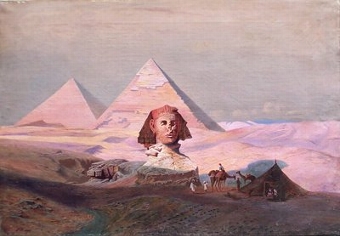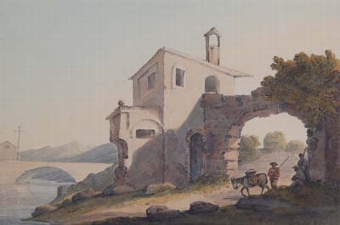reichenbach falls, meyringhen, valle de hasli, canton de berne , switzerland
- View other items in:
- antiques interior design modern and vintage
- other interior design
artware ltd
Enquire about this antique
Artware Ltd has 565 antiques for sale.
click here to see them all
The Reichenbach Falls (Reichenbachfall) are a series of waterfalls near Meiringen in Bern canton in central Switzerland. They have a total drop of 250 m (820 ft). At 90 m (295.2 ft), the Upper Reichenbach Falls is one of the highest cataracts in the Alps. The falls are made accessible by the Reichenbachfall-Bahn funicular railway.
Today, a hydro-electric power company harnesses the flow of the Reichenbach Falls during certain times of year, greatly reducing its flow.
The town and the falls are known worldwide as the setting for an event which never actually happened: Reichenbach Falls is the location where Sir Arthur Conan Doyle''s hero, Sherlock Holmes, apparently dies at the end of "The Adventure of the Final Problem" locked in mortal combat with his arch nemesis, Professor Moriarty. Out of many waterfalls in the Bernese Oberland, the Reichenbach Falls seems to have made the greatest impression on Sir Arthur Conan Doyle, the author of the Sherlock Holmes stories. So impressed was Doyle that he decided to let his hero die there. A memorial plate at the funicular station commemorates Holmes, and there is a Sherlock Holmes museum in the nearby town of Meiringen. The actual ledge from which Moriarty and Holmes apparently fall is on the other side of the falls; it is accessible by climbing the path to the top of the falls, crossing the bridge and following the trail down the hill. The ledge is marked by a plaque written in English, German and French; the English inscription reads: "At this fearful place, Sherlock Holmes vanquished Professor Moriarty, on 4 May 1891."
Reichenbach Falls was also the title of a 2008 BBC Four TV drama by James Mavor, based on an idea by Ian Rankin and set in Edinburgh. Numerous historical characters associated with the city, including Conan Doyle and his mentor Dr Joseph Bell, are mentioned in the story.
Meiringen is a municipality in the district of Oberhasli in the canton of Bern in Switzerland. As of December 2007[update], the population of Meiringen was 4533. The town is famous for the Reichenbach Falls, a spectacular water fall that was the setting for the fictional presumed death of Sir Arthur Conan Doyle''s character Sherlock Holmes. A museum dedicated to Holmes is located in the basement of the deconsecrated English Church, located in what has now been named Conan Doyle Place. The town is also known for its claim to have invented meringue.
Meiringen is served by Meiringen railway station on the Br?nigbahn narrow-gauge railway from Interlaken to Lucerne. This station is also the terminus of the local Meiringen-Innertkirchen Bahn narrow-gauge railway, which links the town with the nearby village of Innertkirchen. The lower terminus of the Reichenbachfall-Bahn funicular, which links the town to the Reichenbach Falls, is located at Willigen, some 20 minutes walk, or a 6 minute bus ride, from Meiringen station.
The Hasli region (also called Oberhasli, or Haslital "Hasli valley") is a historical Landvogtei or Talschaft in the Bernese Oberland, Switzerland, bordering on the cantons of Obwalden, Uri and Wallis. The local dialect is of the Highest Alemannic variety. Since the foundation of Switzerland as a federal state, Hasli has been incorporated as the Oberhasli district, the easternmost of the 26 districts of the Canton of Bern, with an an area of 550 km?, bordering the district of Interlaken to the west. The Oberhasli district consists of six municipalities, Gadmen, Guttannen, Hasliberg, Innertkirchen, Meiringen and Schattenhalb, with a total population of just below 8,000, corresponding to a population density of less than 15/km2 (compared to a Swiss average of 181/km2), due to a significant portion of the area of Oberhasli being uninhabitable High Alps.The name Haslital is first attested in 1234. The prefix Ober- ("Upper Hasli") first appears in the 16th century for disambiguation with Hasle bei Burgdorf, Oberhasli is in official use since 1798. The origin of the name is likely Old High German hasal "hazel". During the High Middle Ages, Hasli was a reichsfrei region administered by an Amtmann. In 1275 if formed an alliance with the city of Berne. In 1311, Hasli was given to the house of Weissenburg by Henry VII. After an unsuccessful revolt in 1334, Hasli passed to the city of Berne as a subject territory in name but regained most of its earlier privileges. Berne was careful to appoint men native to Hasli to administrative posts and as judges. Hasli proved an important ally to Berne militarily. In 1339, Hasli provided a force of 300 men participating in the Battle of Laupen. The arrangement of Hasli as a nominal subject territory with de facto self-governance endured until 1528, when Berne enforced the the Protestant confession in Hasli. About half of the population of Hasli participated in an armed revolt against Berne. After this, Berne tried to enforce Bernese administration in Hasli, but met such resistance that in a 1557 treaty the old privileges were re-instated. In the 17th to 18th century, an upper class of influential families native to Hasli emerged, the so-called Ehrbarkeit. Before the introduction of a separate parish in Innertkirchein in 1709, there was a single parish in Meiringen for all of Hasli. In the 19th century, parishes in Gadmen (1808) and Guttannen (1816) followed. During the existence of the Helvetic Republic, Hasli was part of the Kanton Oberland. Since 1833, it has formed the Oberhasli district. Hasli was organized in fifteen collectives of independent farming estates, the so-called B?uerten, between them forming the Talschaft of Hasli. This structure was replaced by the six municipalities of the contemporary Oberhasli district in 1834. The sovereign law of Hasli (Landrecht) became inactive in 1843, during the Swiss Restauration.
Antiques.co.uk Ref: HGGTT9DP
- Materials:
- Watercolour
- Width (cm):
- 22.86 x 15.24 cm 9.00 x 6.00 ins
Artware Ltd
Artware Fine Art specialises in fine antique, decorative and historical portraits and topographical pictures . We cover a period from the 17th and 18th centuries through to the 19th & 20th Centuries. We have over 150 portraits in stock, which can be viewed on our web site, each historical portrait has well researched biographical information both on the sitter and the artist.
Contact details
18 La gare
51 Surrey row
London
Greater London
SE1 0BZ
UNITED KINGDOM
T: 0207 921 97904
E: greg@artwarefineart.com
W: www.artwarefineart.com














